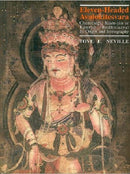The Eleven-Headed Avalokitevara is a study of the many origins that may have played a part in arriving at this number of heads, based on forms and powers: male and female forms; origins based on name; in scriptural evidence and images, as well as Hindu deities, and finally origin seen in Rock-cut litanies in caves of India.
Manifold as the sources are, they led to consideration of this Bodhisattva as the highest form of compassion in the widest sense of the word, the savior for humanity of eight to ten dreads, which assail and defeat humankind, especially for exposed travelers, be they pilgrims going to visit and pray at Buddhist shrines, or monks seeking new temples or to find new masters to teach them.
This essay weaves together a panorama in South Asia, moving up to Central Asian and Chinese cultures who contributed their own examples from caves in China (Tun Huang) that also held depositories of paintings brought back to modern cultures for study in Paris and London; long scrolls such as the Yunan Tali Kingdom’s treasure from the late Sung period, all told tales of Buddhist iconography and styles that most often harked back to earlier Indian models.
Korea found influence from China and Japan had the Eleven-Headed in metal and also of lacquer and wood in splendid examples from seventh and eighth centuries on. Still, most astounding is a theory weaving the thread back to the Indian cave litanies, showing how the Bodhisattva as savior caused in practice of art to furnish the model for how the ten scenes of dreads plus the great Avalokitevara’s own face led to an eleven-headed” giants” seen in Indian Gupta styles.
Tove E. Neville is a Buddhist scholar who has spent nine years in research of Eleven-Headed Avalokitevara in Asia. After traveling in more than 30 countries, visiting important sites of both occidental and oriental art, she settled for fifteen years in Japan. While living in the Orient, she examined especially Chinese and Japanese examples of Buddhist art but also made repeated study trips to India and Southeast Asia, and to special oriental art collections and sites in Taiwan, Korea, France, England and Switzerland Intermittently she pursued her graduate studies in oriental art history at the University of Hawaii.
Ms Neville has received initiation in Theravada Buddhism in Thailand, in Tibetan Buddhism in India and in Shingon (Esoteric) Buddhism in Japan, and has practiced these and Zen meditation over a period of twenty-five years.
Description
The Eleven-Headed Avalokitevara is a study of the many origins that may have played a part in arriving at this number of heads, based on forms and powers: male and female forms; origins based on name; in scriptural evidence and images, as well as Hindu deities, and finally origin seen in Rock-cut litanies in caves of India.
Manifold as the sources are, they led to consideration of this Bodhisattva as the highest form of compassion in the widest sense of the word, the savior for humanity of eight to ten dreads, which assail and defeat humankind, especially for exposed travelers, be they pilgrims going to visit and pray at Buddhist shrines, or monks seeking new temples or to find new masters to teach them.
This essay weaves together a panorama in South Asia, moving up to Central Asian and Chinese cultures who contributed their own examples from caves in China (Tun Huang) that also held depositories of paintings brought back to modern cultures for study in Paris and London; long scrolls such as the Yunan Tali Kingdom’s treasure from the late Sung period, all told tales of Buddhist iconography and styles that most often harked back to earlier Indian models.
Korea found influence from China and Japan had the Eleven-Headed in metal and also of lacquer and wood in splendid examples from seventh and eighth centuries on. Still, most astounding is a theory weaving the thread back to the Indian cave litanies, showing how the Bodhisattva as savior caused in practice of art to furnish the model for how the ten scenes of dreads plus the great Avalokitevara’s own face led to an eleven-headed” giants” seen in Indian Gupta styles.
Tove E. Neville is a Buddhist scholar who has spent nine years in research of Eleven-Headed Avalokitevara in Asia. After traveling in more than 30 countries, visiting important sites of both occidental and oriental art, she settled for fifteen years in Japan. While living in the Orient, she examined especially Chinese and Japanese examples of Buddhist art but also made repeated study trips to India and Southeast Asia, and to special oriental art collections and sites in Taiwan, Korea, France, England and Switzerland Intermittently she pursued her graduate studies in oriental art history at the University of Hawaii.
Ms Neville has received initiation in Theravada Buddhism in Thailand, in Tibetan Buddhism in India and in Shingon (Esoteric) Buddhism in Japan, and has practiced these and Zen meditation over a period of twenty-five years.
Payment & Security
Your payment information is processed securely. We do not store credit card details nor have access to your credit card information.


